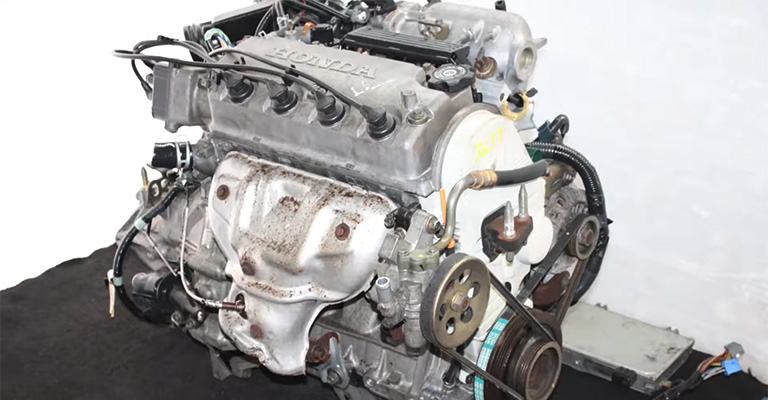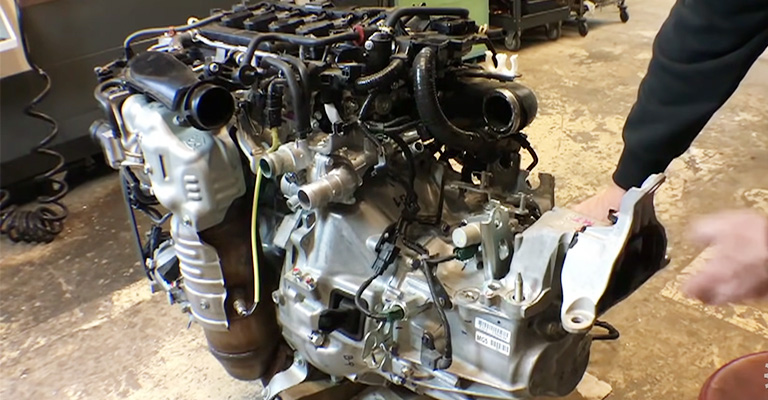Honda Motors has a long history of producing reliable and high-performance engines for their vehicles. Over the years, Honda has consistently pushed the boundaries of engine technology and performance.
The Honda D15Z7 engine is one such example of Honda’s innovative spirit and commitment to excellence.
The Honda D15Z7 is a 1.5-liter 4-cylinder engine that was first introduced in the 1996 Honda Civic VTi EK3 and Ferio Vi models. This engine is known for its compact design, high power output, and impressive fuel efficiency.
With its advanced VTEC (Variable Valve Timing and Lift Electronic Control) technology, the D15Z7 engine was a major step forward in the development of Honda engines.
Understanding the specifications of a vehicle’s engine is crucial for anyone looking to purchase a new or used car. Engine specifications can give you valuable information about the performance, reliability, and efficiency of a car.
Knowing what to look for in engine specifications can also help you make informed decisions when buying a car and give you a better understanding of how your vehicle will perform on the road.
In this article, we will delve into the Honda D15Z7 engine and its specs, as well as provide a performance review of this engine. Whether you’re a car enthusiast or a potential buyer, this article will give you valuable insights into the Honda D15Z7 engine and what it has to offer.

Honda D15Z7 Engine Overview
The Honda D15Z7 engine is a 1.5-liter, 4-cylinder engine that was first introduced in the 1996 Honda Civic VTi EK3 and Ferio Vi models. This engine was designed to be compact, high-performing, and fuel-efficient, and it represented a major step forward in the development of Honda engines.
One of the key features of the D15Z7 engine is its VTEC (Variable Valve Timing and Lift Electronic Control) technology. VTEC allows the engine to adjust the valve timing and lift depending on engine speed, which results in improved performance and fuel efficiency.
The D15Z7 engine has a VTEC switchover point of 3200 and 5800 RPM, and it uses OBD-2 MPFI (Multi-Point Fuel Injection) for precise fuel control.
The D15Z7 engine has a displacement of 1,493 cc, a bore and stroke of 75 mm x 84.5 mm, and a compression ratio of 9.6:1. The engine produces 128 horsepower at 7000 RPM and 102 lb-ft of torque at 5300 RPM.
The engine’s compact design is aided by its 137 mm rod length, which gives it a rod/stroke ratio of 1.62. The engine is equipped with a SOHC (Single Overhead Cam) VTEC system, which has 3-4 valves per cylinder depending on engine speed.
The D15Z7 engine was available with both manual and CVT (Continuously Variable Transmission) transmissions, and it had different ECU (Engine Control Unit) codes depending on the transmission type.
The manual transmission ECU codes were P2J-003 (OBD2a) and P2J-J11 (OBD2b), while the CVT transmission ECU codes were P2J-J61 (OBD2a) and P2J-J71 (OBD2b).
In terms of performance, the Honda D15Z7 engine delivers impressive power and torque, making it an excellent choice for drivers who want a fun-to-drive car that is also fuel-efficient.
The engine’s VTEC technology helps to improve overall performance and fuel efficiency, and its compact design makes it an ideal choice for smaller cars like the Honda Civic. The engine is also lean burn capable, which helps to further improve fuel efficiency and reduce emissions.
In conclusion, the Honda D15Z7 engine is a highly innovative and well-designed engine that offers a perfect balance of performance, fuel efficiency, and reliability.
Whether you’re a car enthusiast or a potential buyer, it’s well worth considering the D15Z7 engine when looking for a high-performing and fuel-efficient power plant.

Specification Table for D15Z7 Engine
| Specification | Detail |
|---|---|
| Engine Type | 4-Cylinder, SOHC VTEC |
| Displacement | 1,493 cc (91.1 cu in) |
| Bore and Stroke | 75 mm × 84.5 mm (2.95 in × 3.33 in) |
| Rod Length | 137 mm |
| Rod/Stroke Ratio | 1.62 |
| Compression Ratio | 9.6:1 |
| Power Output | 128 hp (95.4 kW, 130 ps) at 7000 RPM |
| Torque Output | 102 lb·ft (14.2 kg/m, 139 Nm) at 5300 RPM |
| VTEC Switchover | 3200 and 5800 RPM |
| Fuel Control | OBD-2 MPFI |
| ECU Code | P2J |
| Manual Transmission ECU Codes | P2J-003 (OBD2a), P2J-J11 (OBD2b) |
| CVT Transmission ECU Codes | P2J-J61 (OBD2a), P2J-J71 (OBD2b) |
| Lean Burn Capable | Yes |
Source: Wikipedia
Comparison With Other D15 Family Engine Like D15Z1 and D15Z2 Table
| Engine | D15Z1 | D15Z7 | D15Z2 |
|---|---|---|---|
| Engine Type | SOHC | SOHC VTEC | SOHC |
| Displacement | 1,493 cc (91.1 cu in) | 1,493 cc (91.1 cu in) | 1,493 cc (91.1 cu in) |
| Bore and Stroke | 75 mm × 84.5 mm (2.95 in × 3.33 in) | 75 mm × 84.5 mm (2.95 in × 3.33 in) | 75 mm × 84.5 mm (2.95 in × 3.33 in) |
| Rod Length | N/A | 137 mm | N/A |
| Rod/Stroke Ratio | N/A | 1.62 | N/A |
| Compression Ratio | 9.0:1 | 9.6:1 | 9.0:1 |
| Power Output | N/A | 128 hp (95.4 kW, 130 ps) at 7000 RPM | N/A |
| Torque Output | N/A | 102 lb·ft (14.2 kg/m, 139 Nm) at 5300 RPM | N/A |
| VTEC | No | Yes | No |
| VTEC Switchover | N/A | 3200 and 5800 RPM | N/A |
| Fuel Control | OBD-2 PGM-FI | OBD-2 MPFI | OBD-2 PGM-FI |
| ECU Code | N/A | P2J | N/A |
| Manual Transmission ECU Codes | N/A | P2J-003 (OBD2a), P2J-J11 (OBD2b) | N/A |
| CVT Transmission ECU Codes | N/A | P2J-J61 (OBD2a), P2J-J71 (OBD2b) | N/A |
| Lean Burn Capable | No | Yes | No |
Head and Valvetrain Specs D15Z7 Table
| Specification | Detail |
|---|---|
| Valve Configuration | SOHC VTEC (3-4 valves per cylinder, depending on engine speed) |
| Valve Train | SOHC |
| VTEC Switchover | 3200 and 5800 RPM |
| Valve Lift (intake/exhaust) | N/A |
| Cam Duration (intake/exhaust) | N/A |
| Cam Timing (intake/exhaust) | N/A |
| Cam Profile | N/A |
| Cylinder Head Material | N/A |
| Valves (per cylinder) | 3-4 |
The Technologies Used in
The Honda D15Z7 engine utilizes several technologies to provide optimal performance and fuel efficiency:
1. Vtec (Variable Valve Timing and Lift Electronic Control)
This system adjusts the valve lift and timing, allowing for better performance and fuel efficiency.
2. Obd-2 Mpfi (on-board Diagnostics, Second Generation Multi-point Fuel Injection)
This system ensures precise fuel delivery and reduces emissions.
3. Lean Burn Capability
This technology allows the engine to operate in a lean burn mode, reducing fuel consumption and emissions.
4. Sohc (Single Overhead Camshaft)
This design places the camshaft in the engine block, reducing weight and cost while still providing excellent performance.
5. Vtec Switchover
The D15Z7 engine features a VTEC switchover at 3200 and 5800 RPM, allowing for increased power and efficiency at high RPMs.
Performance Review
The Honda D15Z7 engine is a highly efficient and powerful engine, delivering 128 horsepower at 7000 RPM and 102 lb-ft of torque at 5300 RPM.
This engine was designed to provide a balance of performance and fuel efficiency, making it a popular choice for many drivers.
One of the key features of the D15Z7 engine is its VTEC system, which adjusts valve timing and lift to provide increased power and efficiency at high RPMs.
This, combined with its lean burn capability, allows the engine to operate efficiently, reducing fuel consumption and emissions.
The SOHC design of the engine also helps to reduce weight and cost while still providing excellent performance.
The OBD-2 MPFI system ensures precise fuel delivery and helps to reduce emissions, making this engine a great choice for drivers who are looking for both performance and efficiency.
Overall, the Honda D15Z7 engine is a reliable and efficient engine that delivers impressive performance. Whether you’re looking for speed or fuel efficiency, this engine is a great choice for drivers who demand both.
What Car Did the D15Z7 Come in?
The Honda D15Z7 engine was found in the 1996–1999 Honda Civic VTi EK3 and Ferio Vi models. This engine was designed to provide a balance of performance and fuel efficiency, making it a popular choice among Honda Civic enthusiasts.
With its VTEC system, lean burn capability, and OBD-2 MPFI system, the D15Z7 engine delivered impressive performance and efficiency, becoming a reliable and sought-after engine for those who demand both.
D15Z7 Engine Most Common Problems
Common problems with the Honda D15Z7 engine include
1. Oil leaks
due to aging and worn out engine seals.
2. Valve train noise
caused by worn out rocker arms, camshafts, or lifters.
3.. Engine misfires
due to failing spark plugs, ignition coils, or a clogged fuel injector.
4. Timing belt failure
causing the engine to shut down or cause internal engine damage.
5. Engine overheating
due to a clogged radiator, a faulty water pump, or a failing thermostat.
6. Excessive oil consumption
caused by worn out piston rings or valve guides.
7. Engine knock
due to low oil pressure or incorrect engine oil grade.
If you experience any of these problems, it is recommended that you take your vehicle to a certified mechanic to diagnose and repair the issue. Regular maintenance, such as changing the oil, oil filter, air filter, and spark plugs, can help prevent some of these issues.
Other D Series Engines-

Leave a Reply